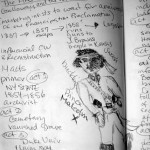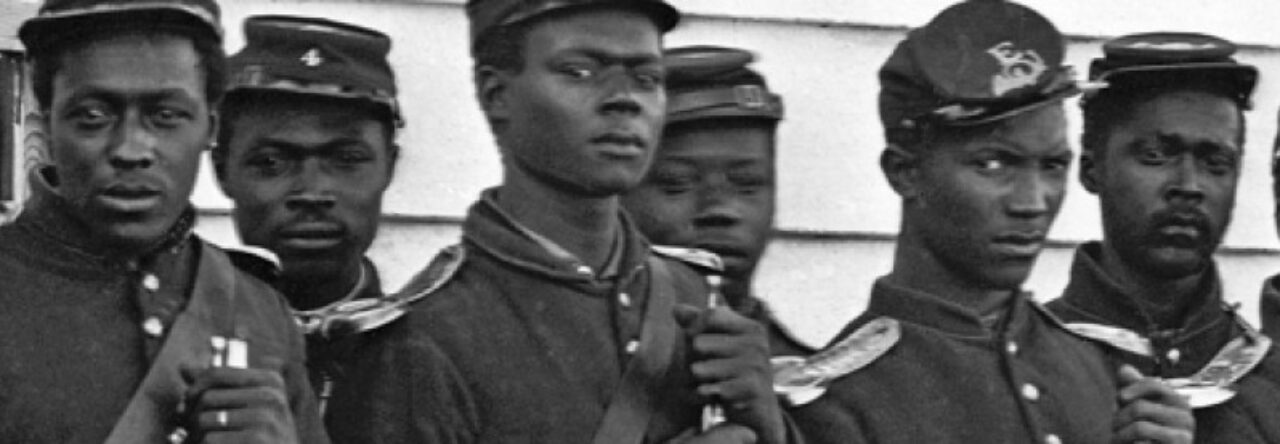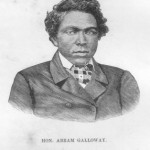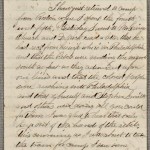Yesterday, I had to take a necessary journey from Michigan to my 95 year old Mom’s home in Richmond , Virginia. I lamented that I was unable to hear yesterday’s lecture and attend yesterday’s on line class. To my great surprise, this a.m., as I picked up the Richmond Times Newspaper, I discovered a daily column – entitled ” From the page of the Daily Dispatch on today’s date in 1862″ . The paper is running a column detailing an article to the corresponding day in 1862 .Content can be gleaned simply by logging on to TimesDispatch.com( search Civil War). Interesting reading
Category: Discussion Page 3 of 9
…(aka BMI-ster), Guide, Recruiter, Organizer, Political Activist, Firebrand, Military Leader, Crusader for Women’s Rights, Senator… and dead before the age of 34.
Now that is a life!
Abraham Galloway, born enslaved, freed himself and was an important figure in the Union Army during the Civil War. He was an important figure in freed and enslaved African American communities throughout his adult life. And rather than saying he worked for the Union army, it might be more accurate to say he worked with the Union army when and if it suited his needs as a leader of the African American community. (When the community was aggrieved by the actions and behaviors of the Union troops, for example, Galloway took names and kicked… but I digress.)
Illiterate, his story and his voice are hard to trace, but historian David Cecelski of North Carolina got lucky and found a trove of letters written by Mary Ann Starkey of New Bern, NC. Starkey was a close confident and fellow activist who worked with Galloway during the Civil War years.Together with his other sources, Starkey’s letters made possible Cecelski’s forthcoming book on Galloway.
I have used the information from Cecelski’s essay on Galloway in The Waterman’s Song, to make a google map of Galloway’s life. He lived large. Zoom way out right away, so that you can see the whole enchilada – North Carolina to Ontario, Ohio to Massachusetts.
I am only up to the year 1863 tonight. More tomorrow. Meanwhile, here is a preview:
In the next few years after 1963, he:
- Met with Abraham Lincoln as part of a five man delegation agitating for suffrage immediately, if not sooner
- Was elected to the North Carolina legislature as a Senator in 1868
- Worked always for the advancement of freedmen and freedwomen
- Died unexpectedly in 1870; it was estimated that 6,000 to 8,000 people attended his funeral in New Bern.*
*The population of the New Bern NC at that time was 5,000.
Galloway was the man. And then he faded from view.
Cecelski’s book on the life of Abraham Galloway, The Fire of Freedom: Abraham Galloway and the Slaves’ Civil War will be released on September 29th, 2012. ( Or you can pre-order it from Amazon, like I did, and save a few bucks.) I strongly recommend you do, too, because Galloway is a guy we are enriched by meeting.
 This is the drawing of Abraham Galloway as I imagined him while I listened to David Cecelski introduce him to me, my NEH buddy Kelly Price-Steffen, (Shout out to ya, Kelly!) and the New Bedford Historical Society last summer.
This is the drawing of Abraham Galloway as I imagined him while I listened to David Cecelski introduce him to me, my NEH buddy Kelly Price-Steffen, (Shout out to ya, Kelly!) and the New Bedford Historical Society last summer.
Now I know it is not a good drawing; he defies gravity and looks like he is related to Burt Reynolds, and yet I feel it conveys the swashbuckling element I intended.
 No, not Tommy Lee Jones and Johnny Cash. The Bureau of Military Information, the BMI! I am intrigued by them. Did not know anything about these sharp (no pun intended) men who were gathering intel long before the CIA made it popular.
No, not Tommy Lee Jones and Johnny Cash. The Bureau of Military Information, the BMI! I am intrigued by them. Did not know anything about these sharp (no pun intended) men who were gathering intel long before the CIA made it popular.
Figured I would find out about the BMI. First search yielded intel on how to measure my body fat. Nope. Not that BMI. I already knew from Matt’s lecture that George H. Sharpe was the lawyer/man running this stealth organization. But, then I read an excerpt on the 70 operatives employed by the BMI. I saw someone’s name, a familiar one, a person well known in Omaha, Nebraska. Grenville Dodge.
Usually known in the history textbooks as the engineer who masterminded the Transcontinental Railroad, Dodge also designed the siege of Vicksburg. But that wasn’t what caught my eye. Dodge created spy networks. Heck, he even employed two women spies, Jane Featherstone and Mary Malone. Dodge protected his well paid sleuths by always refusing to devulge their names. Well, almost always. He once yielded to U.S. Grant. It did not turn out well for the apprehended spies. Not Grant’s fault. But that’s another story.
After the Civil War, Dodge became an Iowa congressional politician and then went on to textbook railroad fame. So, why was I diverted to Dodge? Iowa borders Nebraska (where I reside) and Dodge’s house still exists for tourists (me included) to visit. Today, the main street through Omaha is Dodge Street. Nope. Not for Grenville Dodge, but for one of his relatives, Augustus Dodge.
I started looking for Men in Black and I am far from done. But, I found a Dodge instead. Not bad for an evening’s historical hunting.
“…and students need to appreciate that.”
Matt’s phrasing at the start of the Gettysburg tour is pretty spot on. I love thinking about history in this way, but it is one of the most difficult things for students to grasp. The sheer width and breadth of time is just so daunting.
I’m going through orientation at a new school, and sat in on my first social studies department meeting today. We each shared our favorite topics to discuss in history — mostly basic stuff, like WWII, Civil War, Civil Rights, and so on. One teacher said that he liked to get students thinking about just how many people have lived since the dawn of humanity. Approximately seven billion people populate our planet right now. We might perhaps estimate the total number of people who’ve lived, ever, but surely any such number would be virtually incomprehensible.
The idea of having a living person who actually spoke with a Civil War vet may not at first seem important, but it helps make this enormous planet seem just a little smaller.
So sad listening again to the Gettysburg story of Sam Wilkeson writing beside the body of his 19 year-old son. Another 19 year-old son wrote to his father that day. Charles Douglass’s letter to his father, Frederick Douglass, reports his encounter with some Irish fellows and their differences of opinion about Meade and McClelland. (I especially like this letter because I can actually read it, unlike many letters where I have to retreat to the transcription almost at once.) Despite the racism reported and his angry, blustering reaction, I smiled reading it. He is so young… and so alive.
(His health, it turns out however, prevents him from ever serving in battle.)
Both images link to the loc page where you can view the entire letter – it is 3 pages long – or read the transcription here. (N.b. in the transcript they make mistakes, for example he is talking about Gettysburg with soldiers from Newbern N.C. – not N.Y. Why can’t I find a sound transcript? Annoying!)
My 19 year-old son is out skateboarding right now. He is not worrying about his future, or anything else. I don’t 100% appreciate his lifestyle normally – I think he should be worrying… at least a little – but today I will just go with it.
Huge Changes for my Classroom: Using Technology to Flip the Classroom
The idea of flipping the classroom is becoming more popular as teachers learn about the technique through conversation, web searches, conferences, and other sources. Last year I embraced the technique and so far it appears to be a rewarding experience for myself and students.
Flipping the classroom is not as easy as some make it seem. I can’t tell you how many hours I’ve spent in front of the computer working on this new approach. It has been exhausting.
The first page I created using myhaikuclass.com was an instant success. I had no idea how much the kids liked using this approach until a student asked me if I’ve read the personal comments by the students which could be found at the bottom of the webpage. The following are just a few of the fifty-one comments I received during the first week of the site:
Thanks for setting up this blog Mrs. Abney.(: It is awesome!
i agree this way we say what we feel and what we think should have happenedÐ
i agree as well its the best thing yet;)
yup, i like the vids cuz they educational and funny
This is a great idea and it is really helpful in many ways. I can also listen to music while I write comments (Music helps me concentrate). 🙂 Love the website.
Itz good cuz we can discuss wut was nd wut we think wut should nd shouln’t do , itz just plain fun 4 everyone.
Cool website Mrs.Abney!! When will you update again? Can’t wait!
I’m finally on this website and it is awesome thanks for setting it up
Below you will find a link to a “page” I’m working on for next year (it is under construction):
https://www.myhaikuclass.com/do/share/page/1779643?k=93ac3089d1aef9e793908a8592718bfff896b008
I use myhaikuclass.com. I do pay for the site, but the principal of my school site has decided to pay for the website next year as he sees the value in the technology. I actually had him enroll in the class as a parent and student. He was impressed with the work the students produced, as well as the website. Check it out…I’m definitely an advocate.
There is a story told of a visitor to the cemetery at the Old Soldier’s Home who encountered President Lincoln walking among the grave stones reciting this poem.
It has stuck with me since.
How Sleep the Brave
William Collins. 1721–1759
HOW sleep the brave, who sink to rest
By all their country’s wishes blest!
When Spring, with dewy fingers cold,
Returns to deck their hallow’d mould,
She there shall dress a sweeter sod Than Fancy’s feet have ever trod.
By fairy hands their knell is rung;
By forms unseen their dirge is sung;
There Honour comes, a pilgrim grey,
To bless the turf that wraps their clay;
And Freedom shall awhile repair
To dwell, a weeping hermit, there!
The archives on this sight are unbelievable. My favorite part is the animated battlefield. I was amazed at the number of battles some of these units were involved with like the First Virginia Cavalry they must have been in 20 battles. I liked the assignment ideas Will came up with. The first one was selecting a family and follow them throughout the war. The election of 1860 through newspapers and finally what were women’s lives like. I could see anyone of these being short term or long term projects and being able to set a difficulty level for each of them for example seventh graders could talk about one battle or one person whereas 8th graders could go more in depth.
 Transcription: This morning, as for some days past, it seems exceedingly probable that this Administration will not be re-elected. Then it will be my duty to so co-operate with the President elect, as to save the Union between the election and the inauguration; as he will have secured his election on such ground that he can not possibly save it afterwards.
Transcription: This morning, as for some days past, it seems exceedingly probable that this Administration will not be re-elected. Then it will be my duty to so co-operate with the President elect, as to save the Union between the election and the inauguration; as he will have secured his election on such ground that he can not possibly save it afterwards.
A. Lincoln [signed on the reverse: William H Seward, W. P. Fessenden, Edwin M Stanton, Gideon Welles, Edwd. Bates, M Blair, and J. P. Usher]
I am smitten with the document.
I like the covert aspect: written, folded, blindly signed on the reverse. I can see recreating the signing for my students–I wonder if they will sign blindly like the cabinet or blanch at the uncertainty of it.
I like the emotion of it: Lincoln is agonizingly honest and you can sense the distress.
I like the dissonance it will create for my students. On this side of history, we know Lincoln wins in 1864 handily and Lincoln’s worries will be unfounded. It is helpful, however, to help our young women and men see that history is lived ‘in the moment’ and Lincoln’s moment in August 1864 looks bleak.
That “in the moment” aspect can help make history come alive for my students. When you don’t know how it will turn out, it makes the action more honest, makes the action more profound, more brave.
When I first started teaching US history six years ago, the questions I always got when I started teaching the Underground railroad were the following:
So is the Underground Railroad really a railroad?
Why was it all underground?
My biggest goal in teaching the underground railroad is trying to dispel the misconceptions that students have. Over the years, I have refined my teaching of the Underground Railroad, but one of the challenges has been time. Usually my teaching of the Underground Railroad comes at the end of the year, when I am pressed for time and have so much to get through. Last year, I found an amazing website that is both educational and fun for students examining the underground railroad. It allows the students to get out of the classroom and use technology. The website is is from Scholastic: http://teacher.scholastic.com/activities/bhistory/underground_railroad/index.htm
I like this website because it is geared towards students, but also provided great worksheets that you can print out for the students to use. The students follow the path of the slave from slavery to reaching freedom and the challenges they face.
The first year I used this website it took about 3 days to complete all the worksheets. This past year, I modified it so it took a period and a half and offered the Harriet Tubman webquest as extra credit. I highly recommend using this website and the worksheets.
In the end, the students understand that the Underground Railroad is not a railroad nor is it completely underground. The best part about this though is that it is student centered.










